 Here’s a very schematic map of the northeast section Beijing with my locations marked. I haven’t been anywhere other than this part of town yet, except for the ride in from the airport and the excursion to the Great Wall. Most of this area is the district called Chaoyang, though I’m actually in Dongcheng (just barely). Chaoyang is the largest single district of the city in both size and population, home to over two million people. Dongcheng houses only a half million or so, and is a medium-sized district.
Here’s a very schematic map of the northeast section Beijing with my locations marked. I haven’t been anywhere other than this part of town yet, except for the ride in from the airport and the excursion to the Great Wall. Most of this area is the district called Chaoyang, though I’m actually in Dongcheng (just barely). Chaoyang is the largest single district of the city in both size and population, home to over two million people. Dongcheng houses only a half million or so, and is a medium-sized district.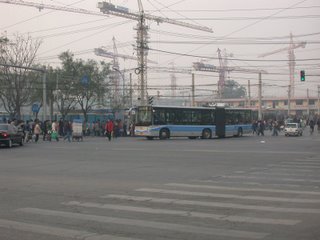 It would seem that I live pretty close to the Xizhimen Bus Station, but I’ve walked by there and didn’t see a station. There are dozens of buses coming and going right around there, but I if there was ever a building there, it’s just a construction site now – no doubt an improved one is in the works for the Olympics. (Edit, much later: The map is definitely wrong. It is the Dongzhimen Station, and Xizhimen is on the other side of town.)
It would seem that I live pretty close to the Xizhimen Bus Station, but I’ve walked by there and didn’t see a station. There are dozens of buses coming and going right around there, but I if there was ever a building there, it’s just a construction site now – no doubt an improved one is in the works for the Olympics. (Edit, much later: The map is definitely wrong. It is the Dongzhimen Station, and Xizhimen is on the other side of town.)I’ve looked up the meanings of some of the place names, and when you break them apart, long, seemingly complicated names like Chaoyangmenwai are pretty simple. You see “men” in lots of names around Beijing, and it means “gate” referring to places where there were once gates in the city walls. Some of the gates still stand, though the walls themselves are almost completely gone. “Chaoyang” means “facing sunlight” (I’m not sure which part is which). “Wai” is very common in street names, and means “outside” as in “outside the gate.” So Chaoyangmenwai means “outside the Facing Sunlight Gate, to put the word order a little more naturally in English. The full name of the street is Chaoyangmenwai Dajie. “Da” means “big” and “jie” means “street,” so “dajie” is sometimes translated as “avenue.” Thus Chaoyangmenwai Dajie means Outside Facing Sunlight Gate Avenue. There’s also a Chaoyangmennei Dajie, Inside Facing Sunlight Gate Avenue.
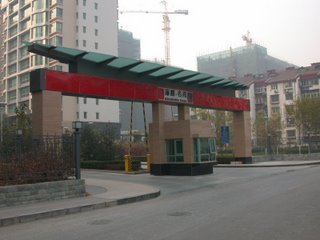 My street, Dongzhimenwai Dajie, is Ouside East Straight Gate Avenue. This apartment complex, Seasons Park, isn’t actually on Dongzhimenwai, but on a side street off of it, but when you give a taxi driver directions, he’s unlikely to know all the little side streets, so you use the nearest big street.
My street, Dongzhimenwai Dajie, is Ouside East Straight Gate Avenue. This apartment complex, Seasons Park, isn’t actually on Dongzhimenwai, but on a side street off of it, but when you give a taxi driver directions, he’s unlikely to know all the little side streets, so you use the nearest big street.All this being said, I haven’t really started learning much Mandarin. I’ve looked these few words up out of curiosity since they figure in my daily life, and it’s my way of remembering the long names, to break them into their component parts.
You can see on the map that Beijing is organized with a series of Ring Roads that circle the center of town. I’m just outside the Second Ring Road. The office is just inside the Third. IKEA is a little way outside the Fourth. Like the streets in many older cities (I know it’s the same in London), Beijing streets tend to change names every so often. Along the bottom of the map, you can see Chang’an Street, which runs between Tian’anmen Square and the Forbidden City, and a little to the east it’s called Jianguomen Street, and still further along it’s Jingtong Expressway (“Highroad” on this map – I think they mean “highway”).
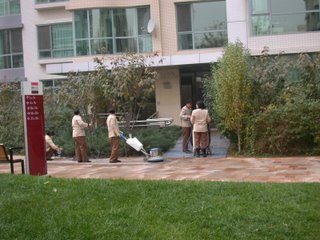 When I left my apartment this afternoon, I encountered this scene. That’s five women in staff uniforms polishing the sidewalk and vacuuming up the water afterward. I swear the path was no cleaner after they were done than it was before.
When I left my apartment this afternoon, I encountered this scene. That’s five women in staff uniforms polishing the sidewalk and vacuuming up the water afterward. I swear the path was no cleaner after they were done than it was before.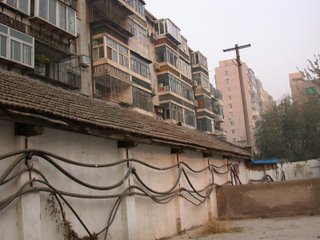 This apartment building is directly opposite the Seasons Park gate. The cables running along the wall intrigue and frighten me.
This apartment building is directly opposite the Seasons Park gate. The cables running along the wall intrigue and frighten me. The shop in this picture is across the street not far from the entrance to Seasons Park. I don’t know what they sell inside, and don’t think I want to.
The shop in this picture is across the street not far from the entrance to Seasons Park. I don’t know what they sell inside, and don’t think I want to. Here’s a common Beijing sight. There’s a newsstand on most every major corner and a lot of minor ones.
Here’s a common Beijing sight. There’s a newsstand on most every major corner and a lot of minor ones.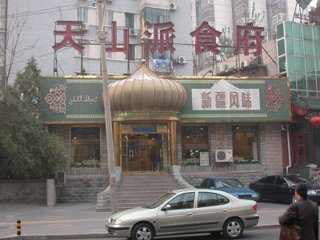 This restaurant is not far away. Notice the Arabic writing on the left side of the sign and the Russian onion dome. You see Arabic on quite a few shops in my neighborhood. China had lots of trade contact with the Middle East back in the days of the Silk Road, which probably explains it. I don’t know what kind of food they serve – I’ll just go in sometime and find out.
This restaurant is not far away. Notice the Arabic writing on the left side of the sign and the Russian onion dome. You see Arabic on quite a few shops in my neighborhood. China had lots of trade contact with the Middle East back in the days of the Silk Road, which probably explains it. I don’t know what kind of food they serve – I’ll just go in sometime and find out.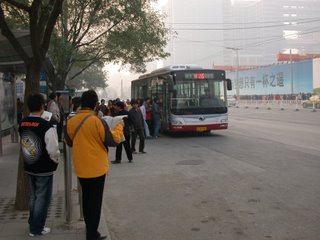 Here’s a bus. Yep, looks like a bus.
Here’s a bus. Yep, looks like a bus. I walked along Dongzhimenwai towards the Second Ring Road, past the bus station (I’m out of order here). There’s an entrance to the subway there, so I went down to see what it looked like. For some reason it’s really hard to get good pictures in the station. Or maybe it has something to do with the fact that I was trying to be inconspicuous taking pictures. Earlier, walking on the sidewalk above, I was aiming the camera along the sidewalk when a three-wheeled bike came along, and the woman riding on the back said something to me and shook her finger at me. Her meaning was pretty clear.
I walked along Dongzhimenwai towards the Second Ring Road, past the bus station (I’m out of order here). There’s an entrance to the subway there, so I went down to see what it looked like. For some reason it’s really hard to get good pictures in the station. Or maybe it has something to do with the fact that I was trying to be inconspicuous taking pictures. Earlier, walking on the sidewalk above, I was aiming the camera along the sidewalk when a three-wheeled bike came along, and the woman riding on the back said something to me and shook her finger at me. Her meaning was pretty clear.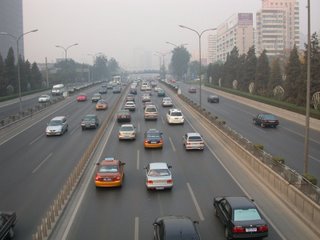 I went back up to ground level and crossed over the Second Ring Road. This is the traffic on Sunday afternoon.
I went back up to ground level and crossed over the Second Ring Road. This is the traffic on Sunday afternoon. NBA player Yao Ming seems to be a national hero here, and promotes the drinking of milk, which isn’t really part of the traditional Chinese diet at all.
NBA player Yao Ming seems to be a national hero here, and promotes the drinking of milk, which isn’t really part of the traditional Chinese diet at all. I am really fascinated by this building that’s going up just on the other side of the Second Ring Road. I took a bunch of pictures of it and it never once shook a finger at me.
I am really fascinated by this building that’s going up just on the other side of the Second Ring Road. I took a bunch of pictures of it and it never once shook a finger at me. As I walked by, I snuck a shot of what appears to be a camp for the workers, where some of them were taking a break.
As I walked by, I snuck a shot of what appears to be a camp for the workers, where some of them were taking a break.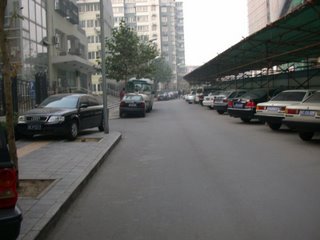 Around the back of that building is a residential street. The sign says it’s a “hutong” which normally refers to the older, traditional streets in the city, but this one must have been remodeled.
Around the back of that building is a residential street. The sign says it’s a “hutong” which normally refers to the older, traditional streets in the city, but this one must have been remodeled. I crossed back over the Second Ring Road, and saw more people getting on and off buses.
I crossed back over the Second Ring Road, and saw more people getting on and off buses.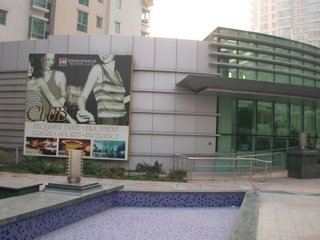 And finally back home. This is the Seasons Park Club House, where there’s a gym and and indoor pool, a restaurant and apparently some kind of disco. I haven’t been in there yet.
And finally back home. This is the Seasons Park Club House, where there’s a gym and and indoor pool, a restaurant and apparently some kind of disco. I haven’t been in there yet.

No comments:
Post a Comment